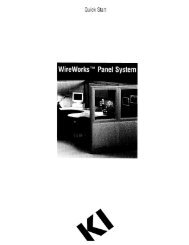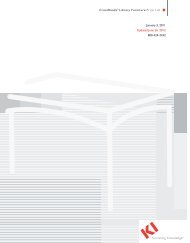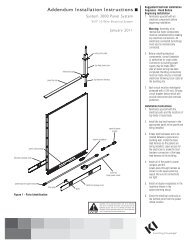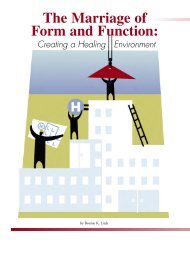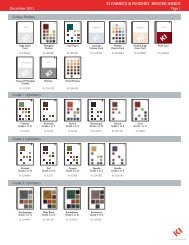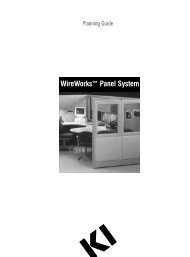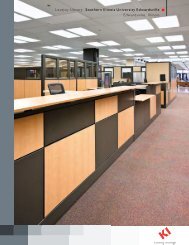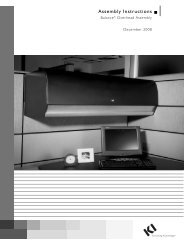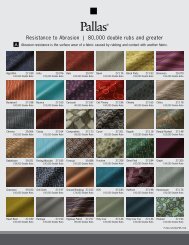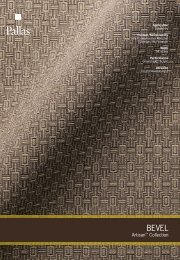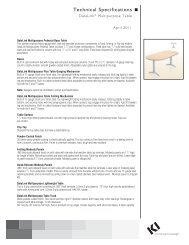Fabric Training Document_FINAL_020708.pdf - KI.com
Fabric Training Document_FINAL_020708.pdf - KI.com
Fabric Training Document_FINAL_020708.pdf - KI.com
You also want an ePaper? Increase the reach of your titles
YUMPU automatically turns print PDFs into web optimized ePapers that Google loves.
INGRADE FABRIC PROGRAM TRAINING02.09.08
<strong>KI</strong> INGRADE FABRIC PROGRAM TRAININGI. INTRO TO THE PROGRAMSince the last introduction of a <strong>KI</strong> in-grade fabric program, there has been a significant shift in contractmaterials for both seating and vertical applications – materials, colors, patterns. The in-grade programbegan to look dated, especially when <strong>com</strong>pared to the refreshed surface materials program. Toprovide a <strong>com</strong>plementary selection of fabrics and finishes, <strong>KI</strong> began researching and refining a new ingradeoffering.The materials used in the program are crisp and clean, often a fresh version of a classic such as crepe.Ushered into contract seating in the 1980s and onto vertical surfaces the following decade, crepe hasbe<strong>com</strong>e a staple of this market. Crepes upholster beautifully, accept color well and can look eithertailored or textural.The color palette is brighter, cleaner and warmer than the previous offering, which looks heavy, darkand rough in <strong>com</strong>parison. As mentioned, <strong>KI</strong> positioned its color palette through the surface materials,which will allow customers and specifiers to coordinate fabrics with finishes.Some patterns and textures are re-emerging in different forms. For example, the texture of Cahootskeeps with today's direction, but the colors are no longer fresh. In these cases, <strong>KI</strong> selected patternssimilar in scope that were offered in a fresh palette.The supply chain was also evaluated as the textiles industry experienced some turmoil recently. Eachsource of supply is reliable and can meet the high expectations of <strong>KI</strong> and its customers.The result is a new fabric in-grade program that parallels the surface materials palette as well ascoordinates, correlates and builds for the future. With improved sampling and Web-based tools suchas See It…Spec It, <strong>KI</strong> is making it easier for customers to do business with <strong>KI</strong>.With the launch of this program, you will also notice a different approach to updating surface materials.In the past, the industry typically introduced surface materials using a “big bang” theory, offering awholesale conversion once every several years. <strong>KI</strong> is advancing from this <strong>com</strong>mon industry practice toone of continuous introductions. That is, you will see updates and improvements to the surfacematerial line on a regular basis. This shift allows several advantages:• More timely releases in response to new trends and material availability• Quicker retiring of dated selections• An ongoing improved balance between classics and trends in color, patterns and materials• An improved ongoing integration with all surface materials as the strategy moves frominfrequent major changes to continuous introductions• Better flexibility, response and support from the supply chainPage 2 of 20
<strong>KI</strong> INGRADE FABRIC PROGRAM TRAININGII. MIGRATIONThe new in-grade fabric program is not designed to be an exact replacement for the former program.However, there are “best suggestions” for those customers who want a fabric that closely matches or<strong>com</strong>plements a previous order.The surface materials team developed migration charts under the theory that when possible, the chartsoffer a “best suggestion” for a new fabric that holds the same place (looks the most similar) in a roomas the former fabric.Sometimes, there are numerous alternate choices given, sometimes just a few. The various optionsmay offer similar color choices, but a range of textures. Or, the choices may capture a diverse aspectof the discontinued fabric. In most instances, substitutions are made within the same grade.In some cases, there are no best suggestions or even a good alternative, because the former fabricswere outdated and the team did not want a new fabric that appeared outdated.Page 3 of 20
<strong>KI</strong> INGRADE FABRIC PROGRAM TRAININGIII. PROGRAM ATTRIBUTESThere are several attributes that are essential to a quality in-grade fabric program for contractapplications. <strong>KI</strong> selected its in-grade fabrics based on the following attributes:• Accessibility – Made in the USA, stocked and readily available• Appearance – Cloths developed according to classic principals, including the primary attributesof enduring quality, interest and style. The fabrics range from established, tried and true solidcrepe to cloths that introduce forward-leaning yarn and surface effects in varieties of plain,texture and pattern.• Approval – Pre-approved across <strong>KI</strong> brands and facilities where feasible• Range and Balance – Within the general contract market’s set limitations – small-scale, highperformanceand broad applicability in fabrication and end-use; the program covers a widearray of styles and achieves color variety• Tailored – Looks good in many upholstery styles, from ergonomic task seating to loungeseating to systems panels• Versatility – The fabric must work on a variety of products for multiple end usesIn addition to these attributes, the <strong>KI</strong> in-grade fabric selections are appropriate for the <strong>com</strong>pany's coremarkets. The brighter, bolder colorways work perfectly for the education market's "school colors" orcan be specified as accents in any market. Specifiers in the healthcare market can select from warmer,spa-like soothing colors. A <strong>com</strong>plete palette of neutrals rounds out the program.Page 4 of 20
<strong>KI</strong> INGRADE FABRIC PROGRAM TRAININGIV. FABRIC ATTRIBUTESThe seating upholstery patterns are named with an architectural theme, while the vertical patterns aremathematical. Within each grade/application, <strong>KI</strong> offers a variety of materials, patterns, textures, surfaceeffects and end-use applications.• End-use – Most of the fabrics are perfectly suited for all general office, educational and healthcareapplications. Some of the fabrics, especially the vinyl ranges, are targeted more specifically towardhealthcare, though they will be <strong>com</strong>fortably applied in our niches.• Hand – Some of the textures are fine, woven with a dense configuration of fine yarns (Foil).Others (Bracket, Thoroughfare and Thatched Roof) are hearty, consisting of heavier, chunkyyarns. Depending on the yarn selection, the hand can feel supple with a soft drape (Urban), whileothers are dry such as the hand of natural linen or cotton (Freeway and Thoroughfare). Themovement is toward refined yarns with texture such as chenille (Thatched Roof) and bouclé(Spackle) and away from older, rustic woolen textures such as tweeds.Left to right: FOIL, BRACKET, THOROUGHFARE, THATCHED ROOF, URBAN, FREEWAY, SPACKLE• Pattern – Contract upholstery fabrics profile a very small-scale pattern <strong>com</strong>pared with other endusessuch as residential furniture. Within the range of acceptable contract scaling, <strong>KI</strong> offers plainfabrics with little or no pattern surface as well as a small-repeat range of both geometric (Bracketand Turret) and organic patterning (Riverwalk, Streetscape and Suburb). Slightly larger-scalepattern offerings will be expanded in the Grade 3 upholstery range. The patterning within thevertical application is subtle, often with vertical elements or with a slightly larger pattern"superimposed" over an all-over ground effect.Left to right: TURRET, RIVERWALK, STREETSCAPE, SUBURB• Surface – By surface, the range is sleek (Foil) to soft (Urban). Some fabrics offer actual dimensionalsurface relief (Spindle), while others only give that illusion (Streetscape or Suburb). Some are veryflat (Foundation) or subtly dimensional (Freeway).Left to right: SPINDLE, FOUNDATION• Trends – The marketplace has shifted. Textures have moved from courser, heavier, casual, rustictextures to refined, dressier, smoother, finer textures, in some cases by adding luster. Colors havemoved from cool (moonlight shades with a blue cast) to warm (sunlight shades with a yellow cast).Page 5 of 20
<strong>KI</strong> INGRADE FABRIC PROGRAM TRAININGV. COLORBy definition, color is never a static element in design application. All color programs need to correlateand coordinate with existing materials, yet incorporate forward-leaning colors such as the warm golds,browns and greens that are emerging; colors have moved from cool (moonlight shades with a bluecast) to warm (sunlight shades with a yellow cast).The <strong>KI</strong> color palette addresses these issues as well as limitations within the fabric itself. Not every fabriclooks good in every color, nor do mills offer every yarn in every color. Therefore, <strong>KI</strong> selected classiccolorways for its in-grade fabric program. And, while it is keyed to <strong>KI</strong> surface materials, the palette isnot static. Rather, it moves toward future color trends mentioned above. The colors are clear, cleanand rich – even in the neutral range.Within each grade and application, the palette offers a <strong>com</strong>prehensive range for selection andspecification. To help illustrate the range, the fabric cards are arranged in quadrants:Reds, Oranges, YellowsNeutrals, Tans, BrownsAquas, Blues, PurplesGreens, Whites, Grays, BlacksPage 6 of 20
<strong>KI</strong> INGRADE FABRIC PROGRAM TRAININGVI. ENVIRONMENTAL STEWARDSHIPAs an environmentally conscious <strong>com</strong>pany, <strong>KI</strong> incorporated sustainable upholstery fabrics throughout theprogram wherever possible and selected vendors with an equal <strong>com</strong>mitment to conserving the planet'sresources.Upholstery fabrics with 100% polyester content:Foundation(Grade 1 or D)Urban(Grade 1 or C)Thoroughfare(Grade 1or C)Upholstery fabrics with 100% RECYCLED polyester content:District(Grade 1 or C)Riverwalk(Grade 1 or F)Foil(Grade 2 or D)Spindle(Grade 2 or D)Parquet(Grade 2 or D)Upholstery fabrics with partial recycled content:Spackle(Grade 2 or C)Vertical fabric with 100% polyester content:Basis V1 Estimation* V1 Quotient* V2Calculation V1 Naturalize V1 Sensa V1*Contains partial recycled contentVertical fabric with 100% RECYCLED polyester content:Graph V2 Pi V2 Reciprocal V2Hypothesis V1 Ratio V2Page 7 of 20
<strong>KI</strong> INGRADE FABRIC PROGRAM TRAININGVII. TOOLSFollowing is a list of tools developed to help understand the in-grade fabric program and specify fabricswithin it.• BPCS and ESpec – The new ingrade program is fully loaded into BPCS and is ready for ordering.All seating fabrics are also in Espec. The verticals will be in Espec in early March.• Cards and Memo Samples – Cards and memo samples can be requested through the literatureordering system at ki.<strong>com</strong>/literature. PDF versions of the cards are posted to the PKB under<strong>Fabric</strong>s & Finishes.• Color Addendum – The PDF version can be found at ki.<strong>com</strong>/pricelists.• Double-rubs Chart – Posted to the PKB under <strong>Fabric</strong>s & Finishes.• <strong>Fabric</strong> Approval Chart – Posted to the PKB under <strong>Fabric</strong>s & Finishes.• <strong>Fabric</strong> Listings & Attributes – Posted to PKB under <strong>Fabric</strong>s & Finishes.• Glossary – Posted to PKB under <strong>Fabric</strong>s & Finishes.• Migration Charts – The Excel spreadsheet is posted to the PKB under <strong>Fabric</strong>s & Finishes.• Product Bulletins – Posted to the PKB.• See It Spec It – This Web-based tool allows you to view fabrics to thread-level detail on <strong>KI</strong>furniture. Visit ki.<strong>com</strong>.Page 8 of 20
<strong>KI</strong> INGRADE FABRIC PROGRAM TRAININGVIII. FREQUENTLY ASKED QUESTIONSPRICINGQ. WILL LIST PRICING FOR NEW IN-GRADE FABRICS BE AVAILABLE AND WHERE WILL IT BESHOWN?A. Yes, list pricing will be developed and displayed in the color addendum.Q. DOES PRODUCT PRICING CHANGE WITH NEW FABRICS?A. No.Q. ARE HIGH POINT PRICING GRADES CHANGING TO MATCH <strong>KI</strong>?A. No. High Point will continue to use letter pricing grades. These grades are being noted on each fabriccard.PROCESSESQ. HOW WILL WE MAINTAIN PRICING FOR FABRICS LIKE INFINITY WHERE THE SUPPLIER IS NOTDISCONTINUING, BUT WE ARE NOT CARRYING INTO OUR NEW FABRIC PROGRAM?A. List pricing will no longer be shown in the color addendum for those fabrics.Q. WILL THESE NEW IN-GRADE FABRICS SHIP IN STANDARD LEAD TIMES?A. Yes. Once fabrics are launched and in inventory, they will be at standard product lead times.Q. CAN WE RESERVE CURRENT IN-GRADE FABRICS THAT ARE BEING DISCONTINUED?A. No.TESTINGQ. HAVE WE TESTED NEW FABRICS FOR UPHOLSTERABILITY?A. Yes, testing is <strong>com</strong>plete.Q. HAVE WE TESTED NEW FABRICS FOR FIRE RATING?A. Yes. However, testing is still in process. The FR status can be found on the fabric approval charts locatedat:S/FABRIC/Automated <strong>Fabric</strong> Appr/<strong>Fabric</strong>ReportGB_IngradeSeatingS/FABRIC/Automated <strong>Fabric</strong> Appr/<strong>Fabric</strong>ReportNonGB_IngradeSeatingQ. WAS PROSPER INCLUDED WITH THE VERTICAL PRODUCT TESTING?A. Yes.Q. HAS GORE TESTING BEEN COMPLETED?A. No. It is in progress along with FR testing.Q. WILL FIRE RETARDANT TESTING BE LOADED IN MAT FILE?A. Yes, with the current default of not tested until results are available.Q. WHERE CAN I FIND DOUBLE-RUB INFORMATION?A. The specifications on the back of each fabric card and memo sample lists the double rubs for that pattern.You can also find the New <strong>Fabric</strong> Program Double Rubs Test Results.doc on the PKB under <strong>Fabric</strong>s &Finishes.TIMELINEQ. WHEN WILL THE NEW IN-GRADE FABRICS BE AVAILABLE?A. The new in-grade program is fully loaded into BPCS and is ready for ordering. All seating fabrics are alsoin ESpec. The verticals will be in ESpec in early March.TOOLSQ. WHERE CAN I FIND FABRIC MIGRATION CHARTS?Page 9 of 20
<strong>KI</strong> INGRADE FABRIC PROGRAM TRAININGA. The fabric migration charts are posted to the PKB under <strong>Fabric</strong>s & Finishes.Q. IF AN OLD FABRIC IS DISCONTINUED, IS THE FABRIC REMOVED FROM BPCS AND E-SPEC?A. Yes. The systems are maintained as product bulletins are released.Q. WHERE CAN I FIND FABRIC INFORMATION AND COLLATERAL?A. Information, collateral and other tools can be found in several places. PDF versions of the cards, migrationtables and the training packet are posted to the PKB under <strong>Fabric</strong>s & Finishes. The PDF of the ColorAddendum can be found at ki.<strong>com</strong>/pricelists. The Web-based See It Spec It tool is at ki.<strong>com</strong>.Q. DOES <strong>KI</strong>.COM SHOW APPROVAL OF FABRICS ON PRODUCTS?A. The new ki.<strong>com</strong>, which will launch in Q1 2008, will have information on approvals that matches theBPCS MAT file. In the meantime, you can find the approval charts at the following locations:S/FABRIC/Automated <strong>Fabric</strong> Appr/<strong>Fabric</strong>ReportGB_IngradeSeatingS/FABRIC/Automated <strong>Fabric</strong> Appr/<strong>Fabric</strong>ReportNonGB_IngradeSeatingQ. CAN ALL COLLATERAL AND INFORMATION BE LOCATED AND ACCESSED IN ONE LOCATION?A. All collateral and information will be posted to the PKB under <strong>Fabric</strong>s & Finishes. It will also be available onki.<strong>com</strong>.MISCELLANEOUSQ. ARE ANY OF THE NEW FABRICS "GREEN"?A. Yes, some use recycled content. Specifications with this information will be located with the electronicfabric cards.Q. IS GROUP 1 VINYL DISCONTINUED?A. No. We will need Group 1 Vinyl for Front Row Seating. The new vinyl selections did not hold silkscreening. Decisions on Group 1 Vinyl colors are pending.Q. WHAT NEW IN-GRADE FABRICS ARE INCLUDED IN THE QUICK SHIP PROGRAM?A. Foundation is the new Quick Ship Program fabric for seating. Naturalize is the Quick Ship Program fabricfor overheads and is a vertical fabric carrying over into the new in-grade offering.Q. IS AUDITORIUM SEATING INCLUDED IN THE NEW FABRIC PROGRAM?A. Yes.Q. WILL THE LANCASTER FABRICS STILL BE AVAILABLE?A. Yes.Q. WHAT WILL BE INCLUDED IN SEATING UPHOLSTERY GRADE 3?A. Three to four patterns will be available with larger scale patterning.Q. ARE THE GROUP 2 VINYLS STILL AVAILABLE?A. Some of the Group 2 Vinyls have been incorporated into the new fabric program and will continue to beavailable. For three patterns, we are adding to the existing colors. In addition, we are adding two new vinylpatterns.WHO SHOULD I CONTACT FOR MORE INFORMATION?Laura Quinn Design x2054 laura.quinn@ki.<strong>com</strong>Jodi Lipsh Communciations x2343 jodi.lipsh@ki.<strong>com</strong>Page 10 of 20
2007 IN-GRADE FABRIC PROGRAM - LISTINGS & DESCRIPTIONSGRADE 1 UPHOLSTERYDISTRICTGrade 1 or CSTREETSCAPEGrade 1 or D1DAR ARMOR1DBE BLACK TIE1DBT BLUEBONNET1DJD JADED1DRD RED RED1DRY RUBYFOUNDATIONA modern “high-tech”version of the crepe thatoffers a slight sheen with aminiscule geometric effect.Grade 1 or D1SBN BLACK & TAN1SBE BLUE ON BLUE1SCD CACTUS SAND1SFL FIRE OPAL1SHB HONEYCOMB1SHA HOT LAVA1SPE PURPLE HAZE1SRT RAINFOREST1STO TUXEDOThe overlay pattern gives theillusion of surface dimensionin a very flat, damask weave.1FBI BLACK IRON*1FBB BLUEBERRY*1FBN BONFIRE1FCV CLOVER1FKP KELP1FMS MOJAVE SUN1FMN MONARCH1FOS OCEAN SURF1FSD SEDIMENT1FSZ SHIRAZ*1FSP SUGAR PLUM1FTG TUNGSTEN*1FTM TURMERIC*A solid pattern that offerssome pebble-relief texture;upholsters well, making itthe gold-standard solid forcontract seating*Denotes QSP fabric.SUBURB1BBT BLUEPRINT1BGD GOLDENROD1BMN MOLTEN1BOT OLD CLARET1BSE SIERRA RIDGEGrade 1 or DA tiny geometric pattern indamask, offered in a mostlywarm palette.FREEWAY1WBL BLACK1WDB DARK BLUE1WDC DARKCHOCOLATE1WGD GOLD1WGN GREEN1WLE LIME1WMB MEDIUM BLUE1WPM PLUM1WRD RED1WSA SADDLE1WSC SPICE1WTN TAN1WTP TAUPE1WWT WHITEGrade 1 or DA dressy, crisp solid in a reppweave.RIVERWALK Grade 1 (HN Grade TBD)1IBN BANYAN1IBE BIOME1ICE CREPUSCULE1IFR FRESH WATER1IJE JUNGLE1IMD MASSAI RED1ISA SAVANNAThe weaves in this organic verticalstripe evoke a rich, dimensionaltexture.THOROUGHFARE1TBO BLUE OPAL1TCL CORNMEAL1TCT CURRANT1TFS FADED JEANS1TGT GARNET1TOE OLIVE1TSL SOFT TEAL1TUH UNDERBRUSHURBAN1RBE BLACK SUEDE1RCM CITRA LIME1RCH COPPERBLUSH1RDA DARKMOCHA1RFL FLOWERPOT1RGE GRENADINE1RPB POOL BLUE1RSD SUGAREDALMOND1RSE SUNNYDAZEGrade 1 or CThe subtle linen-like patternoffers some surface relief;directional and modern yeteasy to work with, it’s offeredin a mostly cool palette.Grade 1 or CSoft, napped surfaces arefresh and directional; it tailorsbeautifully like crepe andoffers a soft hand.Page 11 of 20
2007 IN-GRADE FABRIC PROGRAM - LISTINGS & DESCRIPTIONSGRADE 2 UPHOLSTERYBRACKETGrade 2 or CSPINDLEGrade 2 or D2BAR AMBER2BCI CHAI2BFN FAWN2BFX FLAX2BGL GULL2BIS IRIS2BPT PORT2BST SEAMISTNearly solid with shots ofcolor, making coordinationeasy.2IBK2IBC2IDY2IGF2IHD2IPS2ITEBLACK INKBLUE NORDICDOVE GREYGREEN LEAFHERITAGE REDPERSIMMONSTHISTLEA classic matte lasé with arelief surface; soft, full colors.FOIL2FBX BEESWAX2FBD BLACKBOARD2FBW BLUE SHADOW2FCN CITRON2FHA HENNA2FPE PEBBLE2FPL PLUMAGE2FRE REDSTONE2FSE SLATE2FST SOFT WALNUTGrade 2 or DClean and crisp with a slightsheen; fine texture andsmall-scale pattern.THATCHED ROOF2TBE BLUE DANUBE2TBS BLUE LAPIS2TCF CHOCOLATEWAFER2TDY DARKBURGUNDY2TDL DESERT CAMEL2TMS MEADOW-LANDS2TRE RED OXIDE2TSE SANTE FE2TWN WARM TANGrade 2 or DA soft hand and appealingdimension; a classicchenille in classic colors.PARQUET2QAE ALPINE2QBT BITTERSWEET2QCE CARBON DATE2QCS CHAMOIS2QCW COPPER GLOW2QGY GRAPEBERRY2QLT LIMELIGHT2QMY MERCURY2QNL NAUTICAL2QSA SEPIAGrade 2 or DThis near-solid achieves theillusion of a textural surfacethrough weave effect andcolor contrast; color paletteoffers clear, punchy colors.TURRET2UAL AERIAL2UCE CHARADE2UCI CONFETTI2UKE KALEIDOSCOPE2UME MARIONETTE2UPE PUZZLEGrade 2 or EFine construction in a fun,abstract pattern.SPACKLEGrade 2 or C2PBL BLACK2PBT BULLET2PCT CABERNET2PCD CADET2PGE GRAPE2PMO MANGO2PMA MOCHA2PRT ROCKET2PSP SUGARSNAP2PSE SUNSHINEBouclé that lends itself tobrighter and more clearcolors; rich and fresh colorpalette.Page 12 of 20
2007 IN-GRADE FABRIC PROGRAM - LISTINGS & DESCRIPTIONSLEATHERS & FAUX LEATHERSCELINA LEATHER Grade L1 or L MOUCHETTE FAUX LEATHER Grade 1 (HN only)30993058304031003073301330873101306630223009GENOA LEATHERLGACLGBKLGBELGCLLGCALGCULGEOLGPTLGSILGTEBLACKBURGUNDYCINNAMONEXPRESSONAVYPARCHMENTPEWTERRUBINSPRUCETANTAUPEADRIATICBLACKBONECAMELCHARCOALCHATEAUEXPRESSOPARCHMENTSAFARITAUPESemi Analine Leather:Analine through dyed.Pebble top grain.Grade L1 or MSemi Analine Leather:Chrome tanned & drum dyed.Full grain.1401140214031404140514061407VOUSSIER FAUX LEATHER15011502150315041505150615071508BROWNBURNT TOMATOCHOCOLATECONCRETES<strong>KI</strong>N TONETERRA COTTAWHITE LINEBUTTER RUMCAMELDEEP GREENGREYHAZELNUTINDIGOMAHOGANYSTALLIONGrade 1 (HN only)CLASSIC IMPRESSION FAUX LEATHER1294127812761282127412931272129512911283128612811296127912751280BLACKBLACK ROSEBLUEBERRYBUTTERCHESTNUTCLARETDUNEEGGSHELLEVERGREENKHA<strong>KI</strong>MOCHAOAKSADDLESTORMTRUFFLEWINE SAPGrade 1 (HN only)Page 13 of 20
2007 IN-GRADE FABRIC PROGRAM - LISTINGS & DESCRIPTIONSVINYLS<strong>KI</strong>LKENNY TWEEDGrade 2V OR ESAVOYGrade 2V OR EVKAEVKBTVKCYVKCTVKGRV<strong>KI</strong>EVK<strong>KI</strong>VKNEVKSLVKSTVKSCVKSEPATRIOT PLUSVPAYVPBKVPBY2VTA2VDEVPIE2VLA2VPA2VPG2VSAVPTARENAISSANCEVRCKVRCEVRCTVRCSVRGMVRIEVRPKVRSGVRSEVRWYAPPLE TORTEBITTERSWEETCELERYCLAY POTGINGERICEKHA<strong>KI</strong>NIGHTSHADESISALSLATESPRUCESTONEAQUA GREYBLACKBURGUNDYCONCRETEDEEP PHOENICIANIMPERIAL BLUELARKPARCHMENTPURPLE GREYSAGETERRA COTTACHALKCOBBLESTONECURRANTCYPRESSGYPSUMICE BLUEPEACOCKSAGESPICEWINEBERRYGrade 2V OR EGrade 2V OR EVSAE2VBAVSBKVSBYVSCBVSCCVSCYVSCSVSDEVSDGVSDOVSDYVSDT2VEUVSENVSFGVSMKVSMTVSNYVSSLVSSEVSSYVSTWVSTEVSTCVSWDSIMPLY SQUAREVSAMVSBCVSBSVSBNVSCRVS<strong>KI</strong>VSLSVSSGVSTMVSWRAUBERGINEBAY LEAFBLACKBURGUNDYCAROBCOPPER CLAYCURRYCYPRESSDELTA BLUEDESERT SAGEDOEDOVE GREYDOVE WHITEEUCALYPTUSEVERGREENFOGMINKMISTNAVYSISALSPANISH ROSESTEEL GREYTALLOWTOFFEETURMERICWHITE GOLDALUMINUMBLACKBRASSBURGUNDYCOPPER<strong>KI</strong>WILAPISSAGETHYMEWATERGrade 2V OR ESTRATOSPHEREGrade 2V OR E2VBIVSBX2VCP2VEOVSGS2VMZVSMEVSPY2VTABLUE ICEBORDEAUXCOPPERESPRESSOGRASSMOSSMYSTIC BLUEPOPPYTAUPEPage 14 of 20
2007 IN-GRADE FABRIC PROGRAM - LISTINGS & DESCRIPTIONSGRADE 1 VERTICALSBASIS Grade 1 NATURALIZE Grade 1B1ATB1BRB1CEB1MWB1PMB1SRA classic crepe which upholsters beautifullyand looks rich on a flat plane; the multi-colorblend palette <strong>com</strong>plements Sensa to offer aclassic range.A slight dimensional effect in a drier hand.A stone-like texture with an organic/abstractoverprint motif; the contrasting twist in theyarn configuration lends itself to a darkerpalette – charcoal, chocolate, mocha.A tailored surface with a cross-hatch effectoverlays the basic texture to offer scale-reliefthrough subtle patterning.A continuing classic, its slight metallic sheenjuxtaposes the dimensional effect achievedwith the dobby weave; clear and colorfulpalette.CALCULATION Grade 1 SENSA Grade 1C1AHC1BYC1CEC1CMC1HRC1TOESTIMATION Grade 1E1CEE1CVE1CTE1FLE1GRE1SLE1TEHYPOTHESIS Grade 1H1CRH1CEH1CLH1KTH1PYH1RNALLAGASH MISTBELMONT SILVERCOLBY BLUEMEADOWPLATINUMSHERMAN PEWTERASHBOYSENBERRYCHARCOALMELANGECREAMHEATHERTOBACCOCALCITECAVECELESTITEFOSSILGLACIERSHELLTRACECATERPILLARCHAMOMILECOCONUT SHELLKNIGHTPAPER MONEYRATTANN1642N1647N1649N1644N1640N1648N1641N1645N1638S542S1183S1190S1185S549S1187S1193S540S554BUTTERSCOTCHCELERYEUCALYPTUSGRANITEGRAVELGREEN TEAMAIZESLATE BLUESTONEAUTUMN SMOKEBASSWOODBUTTERMEREEBONY HUEGEMSTONEHUNTERMIDNIGHTWARM SHADOWZINCA classic crepe which upholsters beautifullyand looks rich on a flat plane; the solid colorpalette <strong>com</strong>plements the multi-color blend ofBasis to offer a classic range.Page 15 of 20
2007 IN-GRADE FABRIC PROGRAM - LISTINGS & DESCRIPTIONSGRADE 2 VERTICALSGRAPH Grade 2G2AHG2BEG2HEG2JRG2LEG2PLG2SSG2SEASHBUCKEYEHAWTHORNEJUNIPERLYCHEEPOPLARSASSAFRASSYCAMOREThe cross-hatch of the broken “raised” linesis similar to the effect in Hypothesis, but has amore textural, natural surface.PI Grade 2P2ATP2CEP2ISP2RSP2TYP2WRASCOTCAMBRIDGEINVERNESSRHODESTURNBERRYWINDSORRECIPROCAL Grade 2R2ATR2BNR2CNR2CKR2HOR2PVR2PRR2PGR2SER2SHR2SNR2VTASPHALTBEAU GREENCELEDONCREAM SILKHONEY OATPAVEMENTPEWTERPIGEONSEASIDESQUASHSTOP SIGNVIOLETA flannel effect with small geometric pattern;rich, fuller color palette.The weave effect achieves a subtle intermittentcheck for depth and surface interest. Pi has asoft “suit-like” hand.QUOTIENT Grade 2Q2ADQ2BNQ2CAQ2GYQ2LRQ2PRQ2SRQ2STASTEROIDBLUE MOONCORONAGALAXYLUNARPULSARSOLARSUNSPOTThe high-luster yarn used for the “randomdot” pattern looks fresh and lively against atone-on-tone ground; contrasts mark thebeauty of the fabric – matte/sheen, textural/accent dot, plain ground/abstract dot pattern.RATIO Grade 2R2DNR2MER2MSR2NGR2PNR2PYR2TEDANDELIONMARBLEMOSSNUTMEGPEPPERCORNPUTTYTOFFEEDisperse spheres create a play of all-over/slightly larger scale patterning for interestingcontrast to more plain fabrics.Page 16 of 20
<strong>KI</strong> INGRADE FABRIC PROGRAM TRAININGFABRIC GLOSSARYASTM – American Society for Testing and Materials (ASTM) is a nonprofit organization that provides avoluntary consensus system for developing standards through <strong>com</strong>mittees <strong>com</strong>prised of producers,engineers, academics, regulatory bodies and other stakeholders.ASTM Guide – A <strong>com</strong>pendium of information or series of options set forth by the appropriate ASTM<strong>com</strong>mittee that does not re<strong>com</strong>mend a specific course of action.ASTM Standard – A document developed and established within the consensus principles of ASTM thatmeets the approval requirements of ASTM procedures and regulations.Basket weave (see diagram) – A variation of plain weave in which two or more yarnsare woven together in both warp and fill directions.BLOCKaide – A fluorochemical water- and oil-repellent face treatment for thefabric; makes water and oil bead up on the fabric surface to help prevent staining.BLOCKaide is a trademark of IFG.Brighter Color – “Brightness” is not a technical term with regard to color, but colorsthat are described as “bright” are usually intense (fully saturated to the hue on thecolor spectrum) and clear (remaining close to the hue on the color spectrum withminimal gray <strong>com</strong>ponent or reduction in clarity).Bouclé – An irregular loopy yarn made by twisting heavier, pre-twisted threads around a fine core yarn.Chenille – (1) A yarn that has a pile; made by closely packing a small number of filling yarns, then slicingbetween the groups along a warp line. Chenille yarn resembles pipe cleaners in appearance. (2) <strong>Fabric</strong>woven from chenille yarn.Clearer Color – Clarity of a color refers to its level of pure color <strong>com</strong>pared to gray. “Clear” blue is closeto the pure blue hue in the color spectrum <strong>com</strong>pared with a “duller,” “grayer” or “reduced” blue of thesame hue and value.Colorfastness – The dyed fiber, yarn or fabric’s degree of resistance to exposure of color-destroyinginfluences such as light, abrasion, water or atmospheric impurities.Cool Pallette – Colors that lean to the blue side of the color spectrum are said to be “cool” such as blues,greens and purples; moreover, a rosy-red is cooler than a flame-red.Cotton – A fiber derived from the fruit of plant of the same name, which is used to make the yarn. Variouscotton fibers are classified as to length, strength and geographical origin.Count – The number of warp and filling yarns per square increment of measure in the finished cloth; thenumber of warp ends is mentioned first when referring to fabric count.Crepe – A fabric of crinkled appearance usually a result of the weave, yarn type and finishing techniques.Crypton® – A registered trademark of Hi-Tex, Inc. for a range of materials that are water-repellant andbreathable.Page 17 of 20
<strong>KI</strong> INGRADE FABRIC PROGRAM TRAININGFABRIC GLOSSARYDamask – (1) Originally, a rich silk fabric of woven floral designs made in China and introduced intoEurope through Damascus, from which it derived its name. (2) A construction that produces a reversiblefabric in which areas of high and low luster (satin and sateen) are contrasted to create the figure andground. (3) <strong>Fabric</strong> that features the lustrous satin surface; symmetrical layout; and vase, leaf, and plantmotifs that are typical of traditional damask-woven goods. Usually woven in damask construction but maybe printed or otherwise produced to achieve the effect. Also called framed damasks.Dobby – (1) An attachment to a loom used to facilitate the weaving of small geometric patterns. (2) Thefabrics produced on a dobby loom. (3) <strong>Fabric</strong>s featuring a small all-over geometric pattern.<strong>Fabric</strong> – A more inclusive term than cloth for textiles, plastic films, rugs and carpets, wire mesh and othersimilar materials.Flannel – A light- to medium-weight plain or twill woven that is fulled and usually napped, resulting in afabric with a soft, brushed hand.Geometric Pattern – Any pattern that features straight lines, sharp angles and geometric shapes asmotifs.Hand (Dry Hand) – The way a fabric feels when handled; In England and in older usage, “handle” is usedinstead of “hand” for this term. “Dry” is used to describe fabrics that are less smooth, or have a “toothy”texture. If the hand is “too dry” it would mean unpleasantly rough, but dry is not a negative – a wooltweed or a nubby silk would be a dry texture, <strong>com</strong>pared to a silk satin or wool suiting.Hue – The place a color holds along the color spectrum, i.e. its color name.Jacquard – A mechanism for a loom (also the fabric it produces) invented by Joseph J. M. Jacquard in1801-1804. The Jacquard machine, positioned above the loom, held a set of punched cards that instructedthe loom by means of punched holes corresponding to threads to be lifted in order to create the wovenpattern. Such mechanisms are now usually electronic rather than mechanical. Complicated patterns can bewoven efficiently by jacquard weaving and so fabrics with any non-small-scale pattern are “jacquardwoven.”Luster – The sheen of a fabric or yarn, i.e. the soft glow of its slightly reflective surface.Matelassé – A double cloth with a quilted or padded texture resulting from stuffer yarns inserted betweenlayers; usually jacquard woven in solid or near-solid colors.Mesh – A fabric that has regular openings between the yarns. It may be constructed in any appropriatemethod – knit, woven, nonwoven.Nano-Tex – A leading fabric innovation <strong>com</strong>pany providing nanotechnology-based textile enhancementsto the apparel, <strong>com</strong>mercial and residential interiors markets.Nanotechnology – The technical process of working on the nano-scale – each nano-scale molecule is onemillion times smaller than a grain of sand. Nanotechnology refers to not only the small size of the materialsbeing used, but also how those materials are engineered to perform specific functions.Traditional coatings make garments feel stiff and clog the weave of the fabric preventing breathability.Using nanotechnology, treatments are small enough to attach to individual fibers, delivering superiorperformance characteristics without <strong>com</strong>promising the look, feel or <strong>com</strong>fort of the fabric.Page 18 of 20
<strong>KI</strong> INGRADE FABRIC PROGRAM TRAININGFABRIC GLOSSARYNapping – A finishing process in which the material is passed through abrasive rollers that disturb (similarto brushing) the surface of the fabric. The fabric has a soft hand and a suede-like appearance.Nylon – A man-made synthetic fiber that is strong, durable, exhibits high static and pilling, and lowmoisture regain.Olefin – Polypropylene fiber; a man-made fiber that is bulky but lightweight, can only be solution-dyed andhas a low melting temperature which allows for texturing of the yarn (which can be heat set). The term isinterchangeable with olefin when discussing fiber.Organic Pattern – Any pattern that features motifs that are curved or irregular, as in the natural world,rather than straight lines, sharp angles and geometric shapes. Organic patterns can be abstract or realistic.Pattern Repeat – To produce continuous lengths of fabric <strong>com</strong>mercially, it is designed so that a standarddesign unit containing a specific arrangement of motifs can be repeated across the width and along thelength of a fabric. The horizontal repeat size of a design must divide evenly into the width of the fabric tobe printed or woven.Piece-dyed – <strong>Fabric</strong> dyed in piece, or bolt form, usually in a solid color after it has been constructed.Polyester – A man-made fiber that is high-strength, washable and abrasion resistant, but subject to pilling,collecting static electricity and staining.Polypropylene – A man-made fiber that is bulky but light weight, can only be solution-dyed and has a lowmelting temperature which allows for texturing of the yarn (which can be heat set). “Olefin” is a broaderterm in chemistry that refers to a series of chemicals of a particular structure, but “olefin” and“polypropylene” are used interchangeably when discussing fiber.Primary Color – The three colors in the spectrum that cannot be derived from any other colors; red,blue and yellow.Railroad – To turn a fabric sideways when applying to furniture or walls so that when installed, the fillingyarns run vertically on the furniture.Rayon – A man-made fiber processed from cellulose that is easily dyed and lustrous; chemically similar tocotton. Used alone or as a blend, the yarn is used in a variety of fabrics with a soft hand that drape well.Viscose rayon has been processed into liquid and then extruded into filament and is rayon’s most popularform.Repp – A fabric with a horizontal rib effect characterized by closely spaced warp yarns with ribs or cordsin the filling. A slub yarn is sometimes used in the filling for texture.Saturation – The intensity of a color, i.e. a red and a pink can hold the same hue, or position on the colorspectrum with the difference being that the red is more saturated than the pink as it has “absorbed” moreof the “redness,” or the color itself, while the pink has been made “weaker” with white. The less-intenseversion of a color is its tint.Selvage (Selvedge) – The long, finished edges of a bolt of fabric that run parallel to the warp. The fillingyarns are caught by these end yarns and are usually a stronger yarn than the rest of the warp.Sheen Luster – Note that “shine” is used to describe undesirable, unexpected or excessive luster/sheen.Page 19 of 20
<strong>KI</strong> INGRADE FABRIC PROGRAM TRAININGFABRIC GLOSSARYSlub Yarn – a yarn that features a thick-and-thin effect at seemingly random intervals over the length ofthe yarn.Solution-dyed Synthetic – Fiber that has been dyed while still in the solution state, before beingextruded into filaments.Textural Ground – The “ground” is the background area in a pattern, i.e. the negative space. A fabricwith “textural ground” has texture in the negative space and is not smooth or flat.Thread Count – The measure of cloth density and fineness indicated by enumerating first the number ofwarp ends per inch or centimeter, then the number of filling picks per inch or centimeter in the finishedcloth. For instance, 68x72 means there are 68 warp ends per inch and 72 filling picks per inch in a givencloth.Tone-on-Tone – A color relationship that emphasizes two colors that are closely related in hue (color)and value (lightness/darkness) to achieve a subtle, near-solid appearance.Topped (As Woven, Right Way, Up the Bolt) – To apply fabric on furniture or walls in the samedirection in which it was woven. The warp yarns run vertically once installed/applied and the filling yarnsrun horizontally.Value – Used to describe a color’s relative lightness/darkness irrespective of its hue. Burgundy is darkervalue than yellow, dark blue is deeper value than light blue, etc.Vinyl – A non-woven water repellent film of polyvinylchloride that may be used alone or laminated to abacking fabric.Warm Pallette – Colors that lean to the yellow side of the color spectrum are said to be “warm” –yellows, oranges and reds; lime green is warmer than the green of an evergreen tree.Warp (see diagram) – The set of yarn elements running lengthwise on a loom and inwoven fabrics on the bolt. It is in place before the weft or filling yarns are woven overand under the warp yarns. Individual warp yarns are called ends.Weft (Filling, Woof) (see diagram) – The set of yarn elements in a woven fabric thatruns horizontally or from selvedge to selvedge, crossing and interlacing with the warp.Wool – Fiber derived from the fleece of sheep. The fiber is resilient and may beblended with other natural or man-made fibers.Woven – <strong>Fabric</strong> that is fabricated through weaving on a loom is woven. Woven fabrics are <strong>com</strong>prised oftwo perpendicularly interlaced sets of yarns (warp and weft) that run parallel within each set.Content in this document, specifically the glossary, is from the book <strong>Fabric</strong>s: A Guide for the InteriorDesigners and Architects, Copyright ©2002 by Marypaul Yates, W.W. Norton& Co., Inc., and reprintedhere by permission of the author.Page 20 of 20




